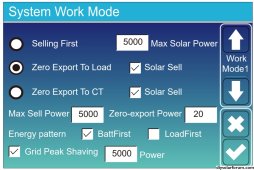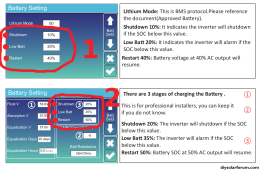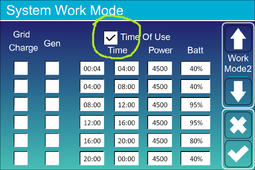Hello,
I am planning to build a 6 kW hybrid solar system that would have 48V batteries and also export excess energy to grid.
I am currently researching which inverter to choose and I am tempted to go with Deye.
However, after reading the manual and forums as well as watching a lot of youtube videos it is still unclear to me if priorities can be set up such that:
1) if solar is available use that first
2) if no solar (night), then use only batteries (until a low threshold is reached)
3) only as a last resource use the grid
4) in all cases, excess solar should be exported to grid
5) never use grid to charge batteries
Some other chinese inverters like the Easun have the SBU mode (solar-battery-utility priority) which is pretty self explanatory, but for the Deye I'm having a hard time figuring out if an equivalent setup can be achieved.
I also see that Deye supports "non-essential loads" circuit that requires a CT as well as an "essential loads" circuit where the loads get connected through the inverter.
It is my understanding (correct me if I'm wrong) that the non-essential side would still consume at least a small amount of grid energy even if it is set to last priority as it would be necessary for the CT to record such a consumption before the inverter would adapt to force only solar/battery energy usage. In this case, am I right in saying that if I want truly 0 grid consumption I should just connect all loads (house, everything) to the "essential loads" circuit and just not bother with the "non-essentials" at all?
Thank you

I am planning to build a 6 kW hybrid solar system that would have 48V batteries and also export excess energy to grid.
I am currently researching which inverter to choose and I am tempted to go with Deye.
However, after reading the manual and forums as well as watching a lot of youtube videos it is still unclear to me if priorities can be set up such that:
1) if solar is available use that first
2) if no solar (night), then use only batteries (until a low threshold is reached)
3) only as a last resource use the grid
4) in all cases, excess solar should be exported to grid
5) never use grid to charge batteries
Some other chinese inverters like the Easun have the SBU mode (solar-battery-utility priority) which is pretty self explanatory, but for the Deye I'm having a hard time figuring out if an equivalent setup can be achieved.
I also see that Deye supports "non-essential loads" circuit that requires a CT as well as an "essential loads" circuit where the loads get connected through the inverter.
It is my understanding (correct me if I'm wrong) that the non-essential side would still consume at least a small amount of grid energy even if it is set to last priority as it would be necessary for the CT to record such a consumption before the inverter would adapt to force only solar/battery energy usage. In this case, am I right in saying that if I want truly 0 grid consumption I should just connect all loads (house, everything) to the "essential loads" circuit and just not bother with the "non-essentials" at all?
Thank you





